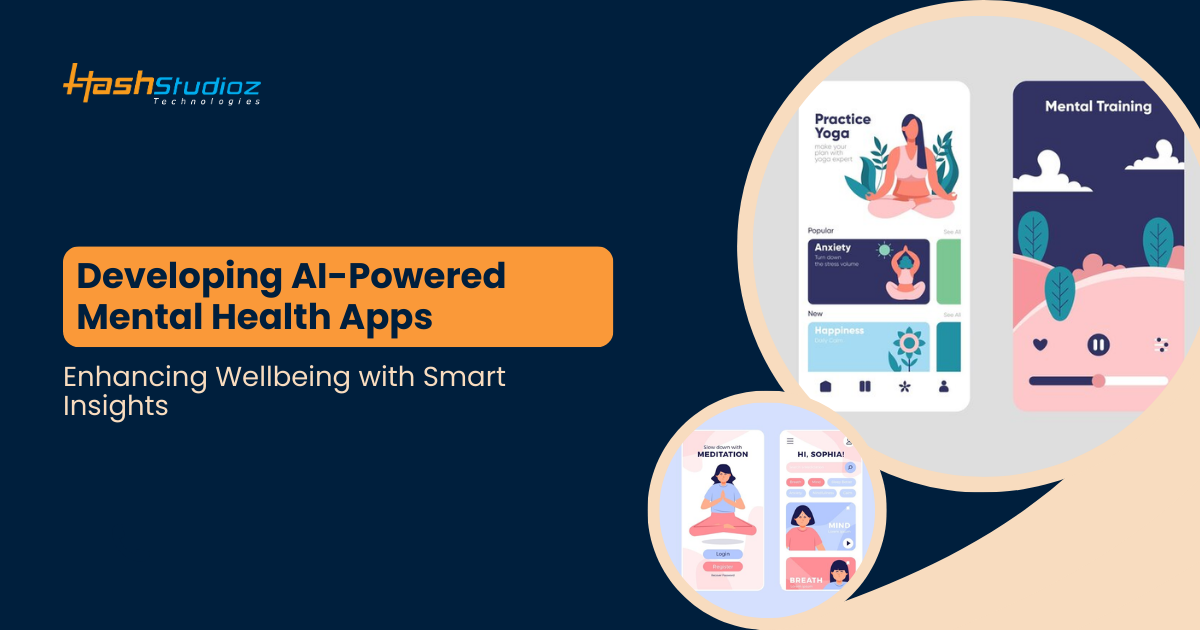Discover Pandipedia
Pandipedia is the world's first encyclopaedia of machine generated content approved by humans. You can contribute by simply searching and clicking/tapping on "Add To Pandipedia" in the answer you like. Learn More
Expand the world's knowledge as you search and help others. Go you!

AI improves mental health app personalization by analyzing user data, such as daily mood logs, sleep patterns, and activity levels, to provide tailored insights and recommendations. For instance, if an app detects increased anxiety, it can suggest specific exercises like mindfulness techniques or relaxation strategies suited to that individual user’s needs[1].
Additionally, AI models utilize predictive analytics to identify early signs of mental health deterioration, enabling timely interventions. By recognizing patterns that may not be visible to humans, such as changes in sleep or activity levels, AI can prompt proactive steps, enhancing users' mental well-being[1][2].
Let's look at alternatives:
- Modify the query.
- Start a new thread.
- Remove sources (if manually added).
- Request a manual search from our human research team.
Introduction to mR2AG
In the ever-evolving field of Artificial Intelligence, particularly in multimodal understanding, the challenge of effectively integrating visual and textual knowledge has gained significant attention. Traditional Multimodal Large Language Models (MLLMs) like GPT-4 have shown prowess in visual question answering (VQA) tasks; however, they often falter when confronted with Knowledge-based VQA tasks, such as INFOSEEK and Encyclopedic-VQA. These tasks require the models to provide specific and accurate answers based on external information rather than relying solely on their pre-existing knowledge base.
To address these limitations, the mR2AG framework—short for Multimodal Retrieval-Reflection-Augmented Generation—has been developed. This innovative approach combines retrieval mechanisms with reflective processes to enhance the performance of MLLMs in answering knowledge-based questions accurately and efficiently.
Overview of mR2AG
mR2AG introduces two critical reflection operations: Retrieval-Reflection and Relevance-Reflection. Retrieval-Reflection determines whether the user query is Knowledge-based or Visual-dependent, thereby deciding the necessity of information retrieval. This adaptive retrieval process helps avoid the unnecessary complexity of retrieving information when it’s not needed, ultimately streamlining the question-answering process.
The second reflection operation, Relevance-Reflection, plays a crucial role in identifying specific pieces of evidence from the retrieved content that are beneficial for answering the query. This allows the MLLM to generate answers rooted in accurate and relevant information rather than vague generalities, which is often a problem with current models.

As described in the paper, mR2AG “achieves adaptive retrieval and useful information localization to enable answers through two easy-to-implement reflection operations, preventing high model complexity”[1]. This efficiency is vital for maintaining the MLLMs' original performance across a variety of tasks, especially in Visual-dependent scenarios.
Performance and Results
The mR2AG framework has demonstrated significant improvements over prior models in handling knowledge-based queries. Comprehensive evaluations on datasets such as INFOSEEK reveal that mR2AG outperforms existing MLLMs by notable margins. Specifically, when using LLaVA-v1.5-7B as the basis for MLLM, applying mR2AG leads to performance gains of 10.6% and 15.5% on the INFOSEEK Human and Wikidata test sets, respectively, while also excelling in the Encycopedic-VQA challenge[1].

One of the compelling aspects of mR2AG is its ability to refine its outputs based on the relevance of retrieved information. The results indicate that by effectively evaluating retrieval content, mR2AG can identify and utilize evidence passages, resulting in more reliable answer generation. “Our method can effectively utilize noisy retrieval content, accurately pinpoint the relevant information, and extract the knowledge needed to answer the questions”[1].
Moreover, mR2AG does not merely improve knowledge-based questioning; it preserves the foundational capabilities of the underlying MLLMs to handle Visual-dependent tasks with similar finesse. This balance between specialized retrieval and generalizeable knowledge is a hallmark of mR2AG's design.
Methodology
The success of mR2AG hinges on its structured methodology. Initially, user queries are classified by type—either Visual-dependent or Knowledge-based. The MLLM generates retrieval-reflection predictions to decide whether external knowledge is necessary. If the model predicts that retrieval is required, it selects relevant articles from a knowledge base, focusing on Wikipedia entries, which are rich in information[1].

Once the relevant documents are retrieved, the model employs Relevance-Reflection to assess each passage's potential as evidence for the query. Each passage undergoes evaluation to determine its relevance, allowing the model to generate answers based on identified supportive content. This layered approach—first distinguishing the need for external information, then pinpointing the most pertinent evidence—significantly enhances the accuracy of responses.
The mR2AG framework also introduces an instruction tuning dataset (mR2AG-IT) specifically designed for Knowledge-based VQA tasks, which aids in the model's adaptability through a structured training process[1].
Conclusion
The mR2AG framework represents a significant advancement in the domain of knowledge-based visual question answering within AI. By integrating adaptive retrieval with precise evidence identification, mR2AG not only enhances the accuracy of answers but also streamlines the complexity typically associated with multimodal models. Its robust performance across various benchmarks demonstrates its effectiveness in tackling challenging knowledge-centric tasks while maintaining the versatility required for visual understanding.

As the AI landscape continues to evolve, frameworks like mR2AG underline the potential for models that can both comprehend intricate visual data and harness external knowledge bases efficiently, setting a foundation for future advancements in multimodal AI systems.
Let's look at alternatives:
- Modify the query.
- Start a new thread.
- Remove sources (if manually added).
- Request a manual search from our human research team.
Get more accurate answers with Super Search, upload files, personalised discovery feed, save searches and contribute to the PandiPedia.

Understanding ASMR

The Autonomous Sensory Meridian Response (ASMR) is commonly described as a pleasant tingling sensation that begins in the scalp and neck and can spread throughout the body. This sensation is triggered by specific audio-visual stimuli, such as whispering, tapping, and gentle hand movements. Individuals who experience ASMR often report that it leads to feelings of relaxation, calmness, and overall positive affect[2][3].
Emotional and Psychological Responses
ASMR triggers a unique blend of emotional responses, characterized by both activation and relaxation. According to studies, ASMR experiences are associated with increased levels of calmness and excitement following exposure to ASMR videos. Specifically, research showed that ASMR participants reported significantly greater improvements in calmness and excitement compared to those who do not experience ASMR[6][10]. Interestingly, ASMR participants also experience reductions in negative emotions such as stress and sadness while watching ASMR videos, leading to a more favorable emotional state overall[8][10].
Furthermore, ASMR is not merely an entertaining phenomenon; it may serve as a therapeutic tool. A study highlighted that participants who experience ASMR often engage with these videos to manage stress and anxiety, showing significant decreases in both state and trait anxiety after viewing ASMR content. This reduction in anxiety is particularly pronounced in individuals already predisposed to higher levels of these emotional states[4][5][8].
Physiological Effects
In addition to psychological impacts, ASMR elicits measurable physiological responses. Research indicates that watching ASMR videos is linked to lower heart rates and increased skin conductance, which are indicators of relaxation and arousal, respectively[7][10]. These findings align with the idea that ASMR can be beneficial for regulating emotional states and may provide substantial therapeutic effects for individuals suffering from mood disorders, including anxiety and depression[6][9].
Individual Variability and Personality Traits
Notably, not everyone experiences ASMR. Only certain individuals are susceptible to this sensation, and studies have explored the personality traits associated with ASMR sensitivity. Research suggests that people who can experience ASMR often exhibit higher levels of neuroticism. This personality trait is linked to a predisposition to anxiety and negative emotional states[4][5]. ASMR experiences might amplify these emotional responses based on the individual's state of mind leading up to the exposure. For example, while ASMR is primarily associated with relaxation, misinterpretation of ASMR stimuli could lead to fear or disgust, particularly in those with high anxiety levels[9][10].
ASMR as a Therapeutic Intervention
Emerging literature supports the potential of ASMR as a non-pharmacological intervention for anxiety reduction. One study noted that all participants, regardless of their experience with ASMR, reported increased relaxation and improved mood after watching ASMR videos, with the most significant effects seen in individuals who regularly experience ASMR[6]. This suggests that ASMR may have therapeutic implications, particularly for individuals dealing with insomnia or depressive symptoms, potentially aiding sleep and reducing stress levels[8][9].
Furthermore, ASMR has been linked with mindfulness-like qualities, as the focused attention required to experience ASMR resembles mindfulness practices that have been shown to alleviate anxiety[6]. The possibility that ASMR can function similarly to mindfulness meditation could open new avenues for therapeutic application in psychological interventions.
Conclusion
The psychological effects of ASMR are diverse, combining emotional relief, physiological relaxation, and potential therapeutic benefits, particularly for those with anxiety disorders. Experiencers report significant improvements in mood, along with reductions in stress and anxiety levels after engaging with ASMR stimuli. Considering the growing popularity of ASMR videos, further research into this phenomenon could solidify its role as a viable method for improving mental health and emotional well-being, particularly for those high in neuroticism or suffering from anxiety disorders[2][4][6][9][10].
Let's look at alternatives:
- Modify the query.
- Start a new thread.
- Remove sources (if manually added).
- Request a manual search from our human research team.
Animals have evolved a diverse array of feeding strategies, adapting their behaviors and physiological traits to maximize their chances of survival in varying environments. These adaptations allow them to locate, acquire, and consume food efficiently, providing insights into the intricate relationship between species and their ecosystems.
Physical Adaptations for Feeding

Many animals have unique physical adaptations that enhance their ability to feed. For instance, the long neck of a giraffe has evolved specifically to reach leaves high up in trees, allowing them to access a food source that few other herbivores can utilize. This structural adaptation enables giraffes to thrive in the grasslands of East Africa, where competition for lower foliage can be fierce[6].
In the aquatic realm, fish are equipped with gills, which allow them to extract oxygen from water efficiently. This adaptation is vital for their survival in a submerged environment. Additionally, animals like whales have developed powerful lungs to extract oxygen from the surface, showcasing another form of physiological adaptation[4].
Predators often exhibit sharp claws or teeth that facilitate hunting and eating. For example, crocodiles possess strong jaws and serrated teeth that help them grasp and hold onto slippery prey, such as fish or birds, in their aquatic habitats[7]. Similarly, the specialized beaks of birds, such as raptors, allow them to catch and tear flesh effectively, supporting their carnivorous diet[9].
Behavioral Adaptations in Foraging
/https://tf-cmsv2-smithsonianmag-media.s3.amazonaws.com/filer/2a/1e/2a1e4c35-2d3d-44d0-916c-23606a5b65da/42-28850284edit.jpg?AWSAccessKeyId=AKIAQT4QH3CHNPX5WHX7&Signature=2kIttcREfEr5fQM%2FFtdzt0XOPK8%3D&Expires=1750913703)
Behavioral adaptations are equally critical in shaping feeding strategies among animals. Many species exhibit foraging behaviors that optimize their search for food. For instance, nocturnal animals like raccoons take advantage of the night to scavenge through garbage and hunt in the cover of darkness, reducing the risk of predation while maximizing feeding opportunities[7].
Migration is another significant behavioral adaptation seen in various species. Birds often undertake long migrations to follow food sources or suitable breeding grounds, such as the Arctic Tern, which travels vast distances between breeding and wintering locations. This seasonal movement ensures access to abundant resources and helps them avoid competition during certain times of the year[9]. Fish like salmon are also known for their migratory habits, swimming upstream to spawn in nutrient-rich freshwater streams[9].
Cooperative and Competitive Strategies
/https://tf-cmsv2-smithsonianmag-media.s3.amazonaws.com/filer/03/09/0309200c-28c4-4e87-b4cd-0709e3ddfd4a/42-33360317edit.jpg?AWSAccessKeyId=AKIAQT4QH3CHNPX5WHX7&Signature=k3c7zkkiCATJYtmK9ZbLwjourv0%3D&Expires=1750913703)
Some animals have evolved to use collaborative methods to enhance their feeding strategies. For example, wolves hunt in packs, allowing them to take down larger prey by coordinating their efforts. This social behavior increases their hunting success rate, enabling them to effectively feed their group[9]. Similarly, elephants exhibit cooperative foraging, where individuals work together to dig for roots or access water in arid environments, demonstrating social behavior that boosts their survival[7].
Competition among species can also shape feeding strategies. Predators and prey often develop adaptations in response to one another; for instance, while prey species enhance their stealth and speed to evade capture, predators become more efficient hunters. The concept of mimicry plays a role here as well. Some harmless species mimic the appearance of toxic or dangerous organisms to deter predators, effectively reducing their likelihood of being targeted while feeding[7][9].
Specialized Feeding Adaptations

Certain species have developed unique adaptations tailored to their specific diets. Carnivorous plants, for example, have evolved mechanisms to capture and digest insects, supplementing their nutrient intake in nutrient-poor environments. These adaptations allow them to thrive in conditions where other plants may struggle[6][7].
Moreover, the Texas blind salamander has adapted to its lightless cave environment by evolving enhanced sensitivity to vibrations in water, compensating for its lack of eyesight. This adaptation is essential for locating prey in complete darkness, demonstrating how animals can adjust their sensory modalities to improve their feeding efficiency[8].
In the harsh environments of deserts, animals like camels have evolved both physical and behavioral adaptations for feeding. They can store fat in their humps, allowing them to survive long periods without water and regulate their energy use efficiently[7]. This ability to adjust their feeding strategies to utilize limited resources effectively is crucial for survival in such extreme habitats.
Conclusion
Through a combination of structural, behavioral, and physiological adaptations, animals have developed diverse feeding strategies that enable them to survive and thrive in a plethora of environments. From the impressive foraging tactics of wolves to the specialized beaks of birds of prey, these adaptations underscore the intricate interconnectedness of life and the driving force of natural selection in shaping behaviors and traits that foster survival in the ever-changing landscape of the animal kingdom. Understanding these adaptations not only enhances our knowledge of biodiversity but also emphasizes the importance of conservation efforts to protect these complex ecosystems and the remarkable species that inhabit them.
Let's look at alternatives:
- Modify the query.
- Start a new thread.
- Remove sources (if manually added).
- Request a manual search from our human research team.
NuWave OxyPure
The best air purifier for large rooms, featuring a high clean-air delivery rate and an advanced multi-stage filtration system with primarily washable parts to reduce ownership costs[1].
Honeywell HPA300
A highly rated air purifier at a lower price, with a two-stage filtration system that effectively handles large spaces but without Wi-Fi connectivity[1].
Winix 5500-2
An affordable option that captures allergens well with its multi-stage filtration system, although it has a modest clean air delivery rate compared to high-end models[1].
Sharp Air Purifier (FP-J80M-H)
Features Plasmacluster Technology and a Spot Mode that targets contaminants, ideal for spacious areas like offices and living rooms[2].
Philips Air Purifier
Utilizes smart sensing technology to monitor indoor pollution and is equipped with a NanoProtect HEPA filter to capture ultra-fine particles[2].
Coway Air Purifier
The top-selling air purifier under 30000 INR, known for its effective HEPA filter that removes 99.99% of viruses and allergens from the air[2].

Dyson Purifier Cool TP07
Offers HEPA filtration, Wi-Fi connectivity, and various modes for effective purification and air distribution, suitable for most households[3].

Dyson Purifier Big+Quiet Formaldehyde BP03
Designed for large spaces, it has a supersized HEPA filter and captures pollutants with low operating noise levels[3].
Daikin MC40XVM6 Air Purifier
Features Streamer Discharge technology, operates at a low sound level, and offers lifetime HEPA filter replacement[2].
Beurer LR210 Air Purifier
Equipped with a smart filtration system that includes a pre-filter and HEPA H13 filter, designed for bedrooms and nurseries, with a Sleep Mode function[2].
Levoit Core 600S
A smart alternative to Honeywell with Wi-Fi connectivity; it offers a marginally lower clean air delivery rate[1].
Levoit Vital 200S
Comparable to the Winix, it features a similar clean air delivery rate but lacks formal HEPA certification on its main filter[1].

Dyson Purifier Hot+Cool Gen1 HP10
Combines air purification, heating, and cooling functionalities, making it a versatile appliance for various needs[3].
HP Air Purifier with UV LED
Uses a 5-stage filtration and is compatible with voice assistants, capable of removing harmful bacteria and allergens[2].
Sharp Professional Air Purifier
Operates on low noise levels and traps up to 99.97% impurities with its triple filter protection[2].

Cubii JR1+ Bundle Under Desk Elliptical
Though primarily an exercise device, its compact design makes it suitable for maintaining activity while ensuring good air quality by operating alongside an air purifier[4].
Let's look at alternatives:
- Modify the query.
- Start a new thread.
- Remove sources (if manually added).
- Request a manual search from our human research team.
Praia da Falésia
Located in Portugal, this beach boasts stunning cliffs and was named the best beach in the world earlier this year by TripAdvisor[6].
Cala Mariolu
A beautiful beach on Sardinia's eastern coastline in Italy, praised for its natural beauty and peaceful atmosphere, ranked among the top three beaches[1][8].
Diamond Beach
An iceberg-covered beach in Iceland, known for its unique landscape and beautiful views[3].

Turquoise Bay
Located in Western Australia, famed for its calm waters and natural beauty, and ranked 6th in the 2024 list of best beaches[3].

Lanikai Beach
Found in Hawaii, celebrated for its picturesque scenery, ranking at #14 in the World's 50 Best Beaches[4][6].
Whitehaven Beach
Located on Whitsunday Island, Australia, renowned for its pure silica sand and clear turquoise waters[7].
Anse Source d’Argent
A notable beach on La Digue in Seychelles, famous for its pristine sands and stunning granite boulders[9].
Black Sand Beach
Situated in Iceland, this beach features pebbles formed from volcanic rock, known for its striking appearance and ranked sixth on the list[5].
Cathdral Cove Beach
Located in New Zealand’s North Island, this scenic spot is ranked 46th on the list of best beaches[3].

Kynance Cove
A beach in Cornwall, UK, celebrated for its azure waters and rugged beauty, it holds a ranking of #48[4].
Hyams Beach
Famous for its stunningly white sand, located on the northern shores of Jervis Bay, Australia[2].
Havelock Island’s Radhanagar Beach
Known for its white sands and lush forest surroundings, located in the Andaman and Nicobar Islands, India[11].
Matira Beach
Found in Bora Bora, known for its turquoise lagoon and coral reefs, highly regarded among beachgoers[2].

Koh Kradan
A less commercialized beach in Thailand featuring stunning stretches of powdery white sand[2].
Grace Bay Beach
Located in Turks and Caicos, known for its calm turquoise waters and powdery white sand[12].
Spiaggia dei Conigli
A crescent-shaped beach on Lampedusa, popular with snorkelers and loggerhead turtles for nesting[12].

Anse Lazio
Located in Seychelles, this beach is highlighted for its large granite boulders and crystalline waters[12].
Playa do Sancho
About consistently rated as one of the world’s best beaches, accessible via ladders or boat amidst steep cliffs[9].

El Bollullo Beach
Found in Tenerife, Spain, known for its wild, natural feel, featuring black volcanic sands[2].
Szántó пляж
This beach is known as the best Puerto Rico and often features in travel articles for its beauty and vibrant atmosphere[7].
White Beach
Located in Boracay, Philippines, famous for its brilliant white sand and clear waters[2].

Playa Zipolite
Known as Mexico’s first and only legal nudist beach, located on the southern coast[2].
Hyams Beach
Renowned for its stunningly white sand located on Jervis Bay in Australia, often celebrated in beach rankings[9].
Cossies Beach
Remote and known for its white-sand beaches, palm trees, and lagoons located on the Cocos (Keeling) Islands, Australia[2].
Let's look at alternatives:
- Modify the query.
- Start a new thread.
- Remove sources (if manually added).
- Request a manual search from our human research team.
Get more accurate answers with Super Search, upload files, personalised discovery feed, save searches and contribute to the PandiPedia.
Colonialism profoundly transformed Africa's political landscape, shaping governance structures and influencing the path towards independence. The effects of colonial rule can be seen in the dominant institutional frameworks that emerged, the resistance movements that arose, and the resultant political dynamics in the post-colonial context.
Institutional Constraints Under Colonialism
Contrary to traditional views that attribute authoritarianism in Africa to colonial “decentralized despotism” or enduring structural factors, recent analyses suggest an alternative perspective. Colonial rule did not entirely dismantle existing local governance structures. Instead, colonial administrations often preserved pre-existing institutions that had constrained precolonial rulers. For instance, the local governance systems known as Native Authorities typically included councils that provided checks on power rather than establishing despotic leadership. This points to a significant degree of continuity in institutional forms from precolonial times into the colonial period.
The compilation of original datasets measuring precolonial institutions and British colonial administrations around 1950 across multiple local governance units reveals that most Native Authorities operated under some type of constraint imposed by councils. Furthermore, many local institutions completely lacked a singular ruler, indicating that although colonial governance was generally authoritarian at the national level, local governance remained more pluralistic[1]. This institutional resilience has critical implications for understanding the persistence of certain governance dynamics in postcolonial states.
The Rise of Independence Movements
Colonialism, while imposing restrictive governance, also inadvertently sowed the seeds for resistance and independence movements across Africa. The educational systems established by colonial powers, along with the involvement of Africans as soldiers in colonial wars, facilitated the dissemination of new ideas that contributed to the rise of anti-colonial sentiments. As African societies began to recover from the initial impacts of colonial rule, these educated citizens and veterans became pivotal in organizing movements aimed at achieving independence.
The historical context of the Scramble for Africa, marked by the invasion and division of the continent by multiple Western European powers, served as a backdrop for these independence struggles. The local populations mobilized against imperial domination, leading to a complex interplay of resistance that ultimately catalyzed movements towards independence. This “struggle” for autonomy was, in part, an unforeseen consequence of the technologies and systems introduced during colonial times, which became tools for political organization and opposition[2].
The Legacy of Colonial Institutions
The legacy of colonial institutions has extended into the postcolonial era, where many nations inherited authoritarian governance structures that were originally designed to control populations and suppress dissent. The correlation between the form of Native Authority institutions under colonial rule and the precolonial institutional framework underscores the challenge faced by newly independent nations. Local councils that existed as forms of governance during colonial times often maintained their influence post-independence, which may explain the persistence of authoritarian regimes in many African countries.
Additionally, the coordinated nature of resistance against colonial rule inspired broader political awareness and organization among diverse groups within African societies. The educational initiatives and military conscriptions under colonial rule inadvertently equipped a generation with the skills and networks necessary to formulate and execute political change. As a result, the legacies of both the institutional constraints and the movements against colonialism revealed the complexities of governance and political identity in colonized regions[1][2].
Conclusion
Colonialism reshaped Africa's political landscape by altering local governance structures while simultaneously fostering a spirit of resistance that led to independence movements. The preservation of precolonial institutions within colonial frameworks created a unique dynamic where local governance continued to exert influence even amid authoritarian control. This duality of continuity and change has had lasting implications for understanding the nature of political authority and resistance in postcolonial Africa, shaping the trajectory of governance and society into the modern era. The interplay of these factors highlights the intricate legacies of colonialism, as African nations navigated the challenges of self-governance in a landscape marked by both historical constraints and emergent aspirations for autonomy.
Let's look at alternatives:
- Modify the query.
- Start a new thread.
- Remove sources (if manually added).
- Request a manual search from our human research team.
Let's look at alternatives:
- Modify the query.
- Start a new thread.
- Remove sources (if manually added).
- Request a manual search from our human research team.

Neural Turing Machines (NTMs) represent a significant advancement in artificial intelligence, merging the capabilities of traditional neural networks with those of computational models akin to Turing machines. Developed by Alex Graves and his colleagues at DeepMind in 2014, NTMs introduce several key innovations that enhance the performance of neural networks in tasks requiring memory manipulation and algorithmic processing.
Memory Augmentation
One of the central innovations of NTMs is the incorporation of an external memory matrix. This memory operates similarly to how a computer interacts with RAM, allowing the network to store, retrieve, and manipulate data over extended time periods. The architecture allows for a clear separation between memory and computation, which overcomes limitations inherent in standard neural networks that typically struggle with tasks that require complex data storage and retrieval processes[3][4][6]. This decoupling enables the controller—often a recurrent neural network (RNN)—to efficiently manage the memory operations independently of the computations performed by the neural network.
Differentiable Operations
The NTMs are designed to operate with differentiable read and write operations, making it feasible to train the entire system end-to-end using gradient descent and backpropagation. This differentiability allows the network to learn how to perform complex tasks by adjusting not only the network weights but also the parameters governing memory interactions[1][6]. The ability to train the NTM in this manner distinguishes it from more traditional systems that do not support such comprehensive learning paradigms.
Attention Mechanisms
NTMs employ soft attention mechanisms, which allow the controller to focus selectively on specific parts of the memory during read and write operations. This attention-based approach is fundamental to how the NTM manages memory locations, providing flexibility in how and when data is accessed. The attention can be based on either the content of memory locations (content-based addressing) or specific location identifiers (location-based addressing)[2][4][6]. This dual addressing mechanism greatly enhances the NTM's capability to perform tasks that require variable binding and processing of structured data.
Learning Algorithms
NTMs have demonstrated their capability to learn simple algorithms from examples, highlighting their potential for tasks requiring logical reasoning and algorithmic-like processing. Early experimental results showed that NTMs could approximate simple algorithms such as copying and sorting sequences, performing associative recall, and even tackling more complex tasks by adapting the learned rules from their interactions with the memory[3][4][6]. This characteristic enables NTMs to generalize well beyond the training data.
Performance Over Standard RNNs

Compared to standard recurrent networks like Long Short-Term Memory (LSTM) networks, NTMs have been shown to outperform them in a variety of memory-related tasks. The NTM's architecture, specifically its external memory and attention mechanisms, significantly enhances its ability to manage state information over time, surpassing the capabilities of traditional RNNs that rely solely on internal memory states[2][3]. This innovation makes NTMs particularly valuable in applications such as sequence prediction, time series analysis, and natural language processing, where state retention and manipulation are critical[1][6].
Challenges and Opportunities
While NTMs present groundbreaking innovations, they also introduce complexities in training due to the interactive nature of the controller and memory. The architecture can be computationally intensive, and careful design of the attention mechanisms is required to optimize performance for specific tasks[6]. Research into improving the stability of training and developing more efficient memory operations remains an active area of exploration.
Furthermore, advancements like the Differentiable Neural Computer, which builds upon the NTM framework, aim to address some limitations in temporal memory linking and enhance overall performance[4][5].
Conclusion
The introduction of Neural Turing Machines marks a pivotal development in the field of artificial intelligence, combining neural network strengths with the memory capabilities of traditional computational models. By leveraging an external memory matrix, differentiable operations, and attention mechanisms, NTMs can efficiently execute complex tasks that require data manipulation over extended time frames. As research progresses, NTMs may play an increasingly important role in developing intelligent systems capable of sophisticated, algorithmic reasoning and learning.
Let's look at alternatives:
- Modify the query.
- Start a new thread.
- Remove sources (if manually added).
- Request a manual search from our human research team.
The Scientific Method: A Foundation for Knowledge
The scientific method serves as a structured approach to investigating questions through observation and experimentation. This dynamic process is not merely a series of fixed steps; rather, it comprises a flexible set of principles that enables inquiry across multiple scientific disciplines. The scientific method is grounded in the formulation of a hypothesis—a testable prediction about the relationship between two or more variables—which is then subjected to systematic experiments that yield empirical data. Following experimentation, researchers analyze the data to ascertain whether the results support or contradict the initial hypothesis, and the findings are subsequently reported to contribute to the broader body of knowledge[3].
The importance of the scientific method cannot be overstated. It minimizes biases and encourages the reproducibility of results, making it vital in addressing societal challenges and advancing various fields. This rigorous process fosters objectivity and reduces the impact of subjective misconceptions, which is essential in producing valid and reliable conclusions[3][10]. Historically, the scientific method’s development traces back to ancient civilizations, evolving through contributions from figures such as Aristotle and later being codified by pioneers like Sir Francis Bacon, which laid the groundwork for future advancements in natural sciences[1][3].
Productivity Myths: What Research Shows
Several common beliefs exist around productivity, many of which have been debunked by research findings. These myths often stem from oversimplified notions of work efficiency, leading individuals to pursue strategies that may not yield the expected outcomes.
Myth 1: More Hours Equal More Output
One of the prevalent myths is that extending working hours directly correlates with increased productivity. Research compiled by the International Labour Organization illustrates that longer hours can lead to diminished results. In fact, individuals working flexible hours or part-time jobs tend to be more engaged and productive than those trapped in longer working schedules, with an optimal work week identified to be around 30 hours for maximizing quality and satisfaction[2][5].
Myth 2: Multitasking Enhances Efficiency
Another widespread misconception is that multitasking is essential for modern work environments. However, studies indicate that attempting to manage multiple tasks simultaneously often results in reduced efficiency and increased error rates. Researchers have found that people who believe they are adept multitaskers tend to underperform compared to those who focus on single tasks[2][8]. The recommendation, then, is to engage in 'flexible single-tasking,' where focus is maintained on one task until completion, followed by a deliberate transition to another task.
Myth 3: Clean Environments Are Necessary for Productivity
The belief that a tidy workspace equates to enhanced productivity is increasingly challenged by research. While some studies suggest clutter can distract and diminish focus, others indicate that a certain level of messiness may actually foster creativity and efficiency for individuals who thrive in less organized settings[2][4]. Individuals are encouraged to adopt organizational styles that feel intuitive to them rather than adhering strictly to conventional cleanliness.
Myth 4: Increased Happiness Leads Directly to Increased Productivity
While there is a general understanding that happier employees tend to be more productive, the relationship between happiness and productivity is more complex than one might assume. Studies reveal that sustained pressure to maintain a positive demeanor can backfire, causing stress and undermining productivity. Negative emotions, such as stress and urgency, can sometimes drive higher productivity in specific situations[2][8][10]. Thus, a nuanced approach that recognizes individuals’ need for emotional authenticity may enhance overall productivity more effectively than a simplistic focus on happiness alone.
Myth 5: Hard Work Guarantees Success
The notion that sheer hard work is the most reliable path to success overlooks the role of chance in achieving outstanding results. Evidence indicates that not all hard work yields equivalent outcomes and that factors beyond an individual's control, such as luck and external conditions, play significant roles. Therefore, emphasizing effective strategies and productive environments alongside hard work may be more beneficial than solely relying on effort[2][9].
Conclusion
In summary, while the scientific method remains fundamental to the advancement of knowledge, productivity myths often distort perceptions of what constitutes effective work practices. Debunking these myths is essential to cultivate a more informed understanding of productivity that aligns closely with empirical evidence. Acknowledging that productivity is influenced by numerous factors—including effective work schedules, collaboration strategies, emotional well-being, and adaptive work environments—can lead to improved outcomes for individuals and organizations alike[1][3][10]. To thrive in increasingly complex environments, individuals must move beyond these misconceptions and adopt practices grounded in scientific inquiry and evidence-based strategies for productivity.
Let's look at alternatives:
- Modify the query.
- Start a new thread.
- Remove sources (if manually added).
- Request a manual search from our human research team.









































































